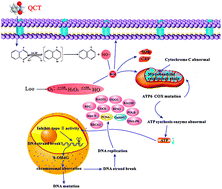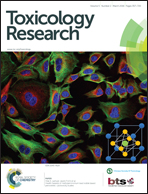Genotoxic risk of quinocetone and its possible mechanism in in vitro studies†
Abstract
Quinoxalines possessing the quinoxaline-1,4-dioxide (QdNOs) basic structure are used for their antibacterial action, although their mechanism of genotoxicity is not clear. After comparing the sensitivity of V79 cells and HepG2 cells to quinocetone (QCT) and other QdNOs, it was found that HepG2 cells are more sensitive. The results show that QCT induces the generation of O2˙− and OH˙ during metabolism. Free radicals could then attack guanine and induce 8-hydroxy-deoxyguanine (8-OHdG) generation, causing DNA strand breakage, the inhibition of topoisomerase II (topo II) activity, and alter PCNA, Gadd45 and topo II gene expression. QCT also caused mutations in the mtDNA genes COX1, COX3 and ATP6, which might affect the function of the mitochondrial respiratory chain and increase the production of reactive oxygen species (ROS). Nuclear extracts from HepG2 cells treated with QCT had markedly reduced topo II activity, as judged by the inability to convert pBR322 DNA from the catenated to the decatenated form by producing stable DNA–topo II complexes. This study suggests that QCT electrostatically bound to DNA in a groove, affecting the dissociation of topo II from DNA and impacting DNA replication. Taken together, these data reveal that DNA damage induced by QCT resulted from O2˙− and OH˙ generated in the metabolism process. This data throws new light onto the genotoxicity of quinoxalines.


 Please wait while we load your content...
Please wait while we load your content...